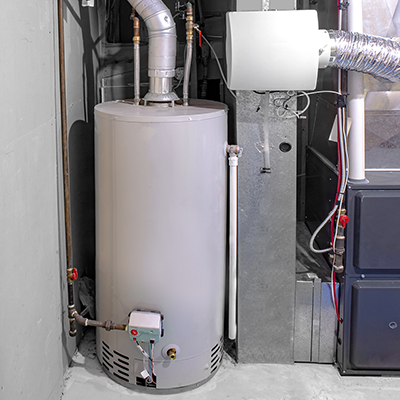How to Drain a Water Heater

Published June 12, 2024
A water heater can weigh well over 100 pounds empty. When you consider that 50 gallons of water weighs about 400 pounds, it makes sense to remove that water if the tank needs to be moved for repair or replacement. This guide will help you empty a water heater.
SHOP WATER HEATERS NOW
Difficulty:
Beginner
Duration:
Under 2 hours
Table of Contents
Reasons to Drain a Water Heater
Turn Off Electric Power or Gas
The Drain Valve
Release the Air Lock
Speeding Up The Process
If the Valve Doesn't Work
Reasons to Drain a Water Heater

Flushing a hot water heater is part of general maintenance, but there are other situations where a water heater tank might need to be drained.
- It needs to be moved.
- It needs to be emptied for a repair, like changing the valve or replacing a heating element.
- The house will be vacant for a period of time.
Tankless water heaters don't have a large quantity of water to drain, but residual water may be left inside when not being used. Consult the operator's manual for guidance when working on a tankless water heater.
Turn Off Electric Power or Gas

Before removing the water, turn off the electricity or gas.
- Heating an empty water heater will cause permanent damage, most likely requiring a replacement.
- For electric water heaters, turn off the electric power at the breaker or unplug it (some water heaters are equipped with a plug like an electric range).
- For gas water heaters, turn off the valve that supplies gas to the water heater.
The Drain Valve

- Water heaters have a drain valve on the front near the bottom of the unit.
- This valve has the same threads as a spigot.
- Attach a garden hose to the valve to direct the water into a drain or outdoors.
- A washing machine hose will also work if there is a drain nearby.
Release the Air Lock

The water system is closed, so air must be allowed into it so the water can flow out.
- If the water heater is being drained for long-term disuse, open a hot water faucet in the house.
- If the water heater is being removed, disconnecting the water connections is the easiest way to release the air, since they’ll be disconnected anyhow as part of the removal.
- Opening the pressure relief valve is another alternative.
Speeding Up The Process

- If you’re a homeowner and will only drain a water heater occasionally, it makes sense to wait for gravity to drain the water heater. It should take 30-45 minutes to drain an average-sized unit.
- If you’re a plumber and draining water heaters is a daily occurrence, owning a transfer pump makes financial sense. A pump can empty a water heater in just a few minutes.
If the Valve Doesn't Work

If the water heater no longer works and is to be replaced, there’s a good chance that the drain valve is clogged. In some cases, the valve can be clogged to the point that it can’t be cleaned.
If the water heater will be repaired, it makes sense to replace the valve. Here’s how:
- Make sure all faucets in the house and inlets to the tank are closed. This will create an airlock that significantly slows the water running out.
- Put a towel or shallow catch basin in front of the water heater to catch the water that runs out.
- Get a 3/4-inch valve prepared with a 4-inch pipe nipple.
- Open the new valve.
- Wrap the threads in thread seal tape.
- Use a pipe wrench to remove the old valve.
- Quickly replace the valve with the new one.
- Once installed, close the new valve and attach the hose for draining.
If the water heater is going to the recycling station, there’s another way to empty it without the expense of changing the valve.
Disconnect the water lines going into and out of the tank.
- To use a larger hose and make it go faster, remove the smaller fitting to open a larger hole.
- An alternative is to remove the anode rod and use that opening.
- Push a hose through the opening and into the tank.
- Siphon or pump the water out of the tank.
Draining as Part of a Maintenance Routine

- Water heaters should be maintained by draining the water and flushing the tank on a routine basis. The most common recommendation is once per year.
- This guide focuses on how to drain a water heater to work on it, replace it or leave it empty for long term storage.
Whether you are draining a water heater for disposal or emptying it for winterization, we’re here to help.
From water heaters to replacement valves, The Home Depot delivers online orders when and where you need them. Find the tools and supplies you need to get started today.




























